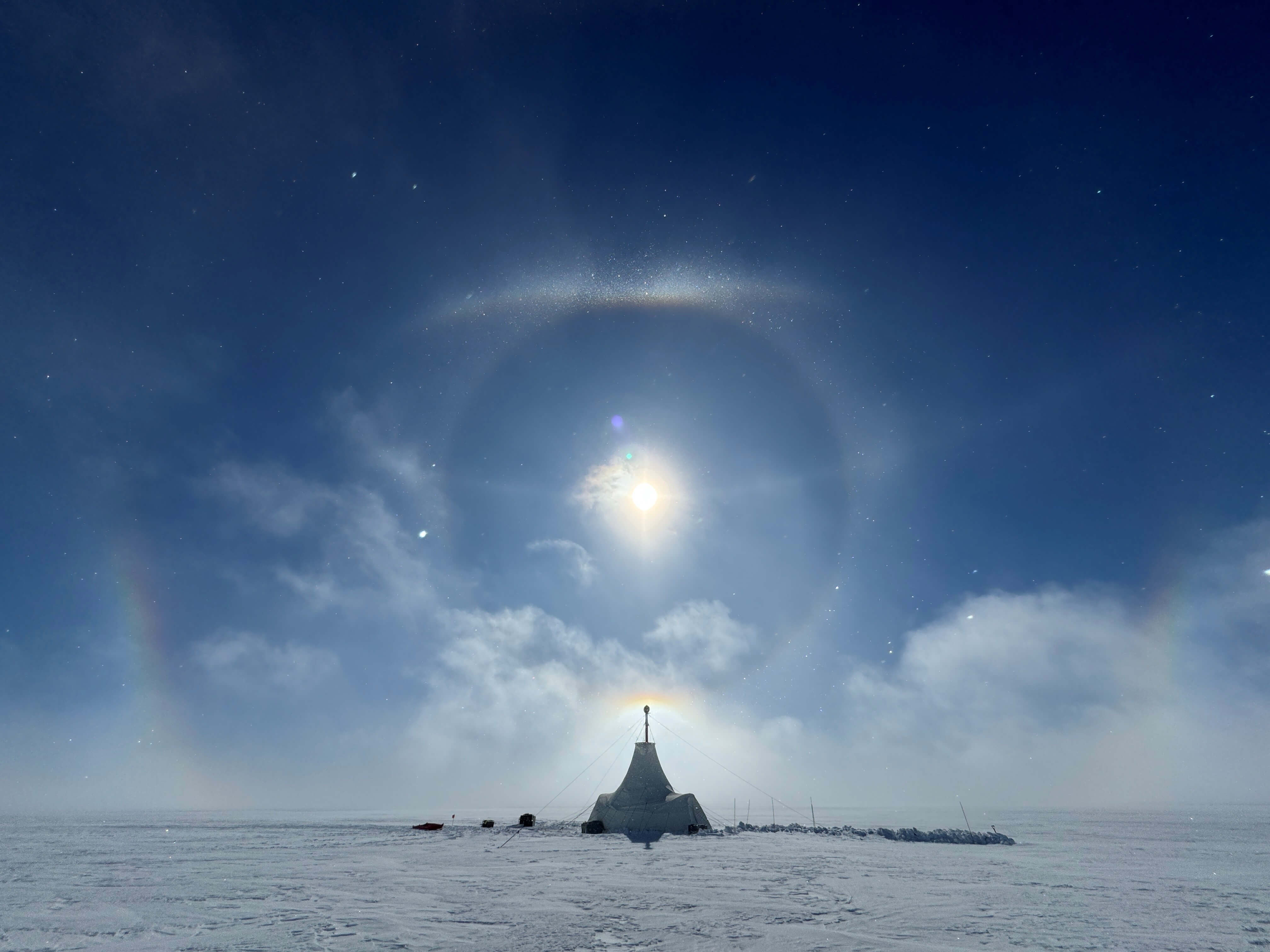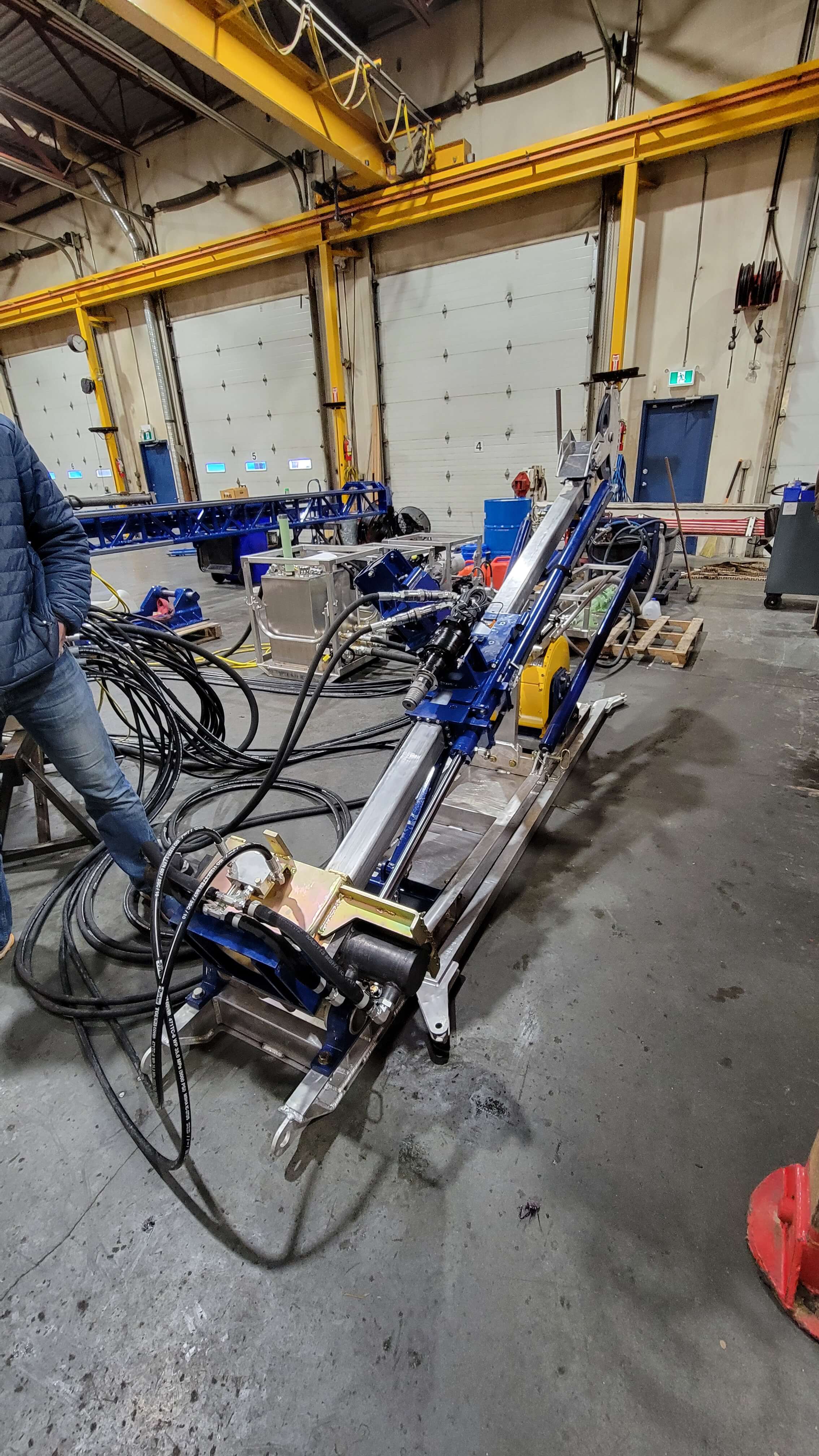IDP Completes Support of 2023-2024 Antarctic Field Season
- Fieldwork
At Allan Hills, driller Elizabeth Morton used an Eclipse Drill to drill to 89.31 meters in support of the first drilling season for COLDEX (I-187-M; PI Shackleton). Several small rocks were encountered in the hole, limiting borehole depth for the season, but the hole may be re-entered and deepened during the 2024-2025 season. Driller Mike Jayred set-up the Blue Ice Drill (BID) at a nearby location and worked with IDP engineers in Madison to troubleshoot some control box challenges. The BID was used to drill and collect ice core to 144.27 meters depth. The BID hole may also be deepened during the 2024-2025 season. The science team conducted additional shallow coring at various locations using hand augers.
Despite significant aircraft and traverse delays and challenges as well as weather impacts, IDP engineers Barb Birrittella and Tanner Kuhl successfully operated the Rapid Air Movement (RAM) Drill around WAIS Divide and the Small Hot Water Drill (SHWD) on Lower Thwaites Glacier (LTG) in support of the GHOST project (C-442-M; PI Anandakrishnan). Fourteen holes were drilled with the RAM Drill around WAIS Divide to a depth of 35-45 meters. The old drilling arch at WAIS Divide, occupied between 2007-2016, was accessed and a 2km long fiber was lowered into the DISC Drill (WDC06A) borehole. Seismic shots were then detonated in the RAM Drill holes surrounding the arch to collect bed-mapping and depth data. At LTG, thirty-two holes were drilled with the SHWD to 50 meters for seismic survey work.
After the Australian Antarctic Program had to postpone their drilling for 2023-2024, IDP quickly worked to contract with Icefield Instruments Inc. for the services of driller Etienne Gros. Following an ocean voyage on the Korean Polar Research Institute (KOPRI) RV Araon, Gros operated the Foro 400 Drill on Canisteo Peninsula with the help of PI Peter Neff (I-345-M) and graduate student Julia Andreasen. The depth goal of 150 meters was reached in only six drilling days following efficient cargo and personnel transport between the RV Araon and the Canisteo Peninsula field site with two helicopters.
Drill Development and Maintenance/Upgrade News
- 700 Drill
- Agile Sub-Ice Geological Drill
- Winkie Drill
- Foro 400 Drill
- BASE Drill
Development of the 700 Drill continued at an excellent pace. The control box and console wiring were completed, and the control box was powered up and tested. The design of the chip bailer continued, and sonde components like the outer tube, hollow shaft, and core barrel were fit-checked. IDP met with personnel at the UW Physical Sciences Lab (PSL) to coordinate the testing of subsystems in the PSL test well. Work continued on the sonde electronics. The motor torque test stand was assembled, and engineers immediately began gathering and analyzing data. Orders were placed for core processing and fluid handling system components. The drill cable was successfully spooled onto the winch. The first use of the 700 Drill is scheduled for the summer of 2024 in support of PI Eric Saltzman’s molecular hydrogen (H2) project (NSF award 2243540) at Summit, Greenland.
The Engineering Requirements document for the BASE (Basal Access and Subglacial Exploration) Drill system was finalized and approved. Drill rod was ordered and received. Jay Johnson and Elliot Moravec traveled to Multi-Power Products Ltd in Kelowna, BC, in February for drill acceptance and operational training. IDP expects to receive the drill in Madison, WI, in March or April, and will work to design the auxiliary components for use of the drill in ice in the polar regions.
In preparation for the second GreenDrill season, a level wind option was purchased for the Agile Sub-Ice Geological (ASIG) Drill, as well as Kubota engine spares, drill rod end caps, rod scraper rings, Geoblock for the drill tent and generator tent flooring, and a replacement flow jet pump. IDP engineers also worked to design improvements for the ASIG Drill chip handling and filtration system. The Winkie Drill packer and the water swivel seal were tested, and filter socks, casing centralizers, and full-face and impregnated bits were purchased. Additional Winkie Drill casing was ordered and received to account for GreenDrill firn depth uncertainty, and work on a new insulated filtration tank was completed.
Work continued on new outer tubes for the Foro 400 Drill, and components for a new truss tower were received.
IDP Education and Public Outreach Workshops Increase Impact
- Education/ Outreach
- Meetings/ Workshops
The results of the pilot Train the Trainers Workshop held last summer at the NSF Ice Core Facility in Denver, CO, have been very exciting. Seven participants have already planned outreach activities that broadened IDP education and outreach impact. In addition, about half of the fifteen participants have either completed a professional development outreach project or have one planned.
New Virtual Field Lab: Sea Level Rise and Thwaites Glacier: Vital Signs of the Doomsday Glacier
- Education/ Outreach
In IDP’s latest Virtual Field Lab, Sea Level Rise and Thwaites Glacier: Vital Signs of the Doomsday Glacier, Dr. Richard and Dr. Karen Alley take students to Antarctica to analyze the stability of Thwaites Glacier. Vital signs are taken using satellite imagery to see how much sea levels may rise in the future. Two lab episodes are available on the icedrill-education.org website, and a third episode will be released soon.
The Virtual Field Labs are unique interactive education and outreach products designed for students from late middle school to college. The labs are designed for students to watch with a teacher present (virtually or in-person) or independently on their computers. Each Virtual Field Lab takes students along with a climate scientist as they collect and analyze data to answer a different climate question. There are currently five Virtual Field Labs, each containing three video episodes. Visit the Virtual Field Labs webpage for a description of each lab.
IDP Hosts Successful Town Hall at 2023 AGU Fall Meeting
- Meetings/ Workshops
- Long Range Plans
IDP organized and convened the AGU Town Hall on Scientific Drilling in the Polar Regions at the AGU Fall meeting in San Francisco (December 14, 2023). The session attracted a large audience who heard brief presentations from IDP (Mary Albert), International Partnerships in Ice Core Sciences (IPICS; Christo Buizert), Ice Core Young Scientists (ICYS; Jennifer Campos Ayala), Hercules Dome (Eric Steig), GreenDrill (Jason Briner), and Rapid Access Ice Drill (RAID; Shuai Yan).
Ice Drilling Support for NSF Polar Proposals
- Funding Opportunities/ Solicitations
- Education/ Outreach
If you are preparing a National Science Foundation (NSF) proposal that includes any kind of support from IDP, you must include a Letter of Support from IDP in the proposal. If your fieldwork requires support from the U.S. Antarctic Program (USAP), you should include a Letter of Support from IDP in the pre-proposal Concept Outline (see NSF 23-509 for more details) .
Researchers are asked to provide IDP with a detailed support request three weeks prior to the date the Letter of Support is required. Early submissions are strongly encouraged.
Scientists who seek to include IDP education and outreach activities associated with U.S. ice coring or drilling science projects should contact Louise Huffman at Louise.T.Huffman@Dartmouth.edu during their proposal preparation stage.
For additional information on requesting IDP support, visit our website at https://icedrill.org/requesting-field-support or contact us at IceDrill@Dartmouth.edu.












